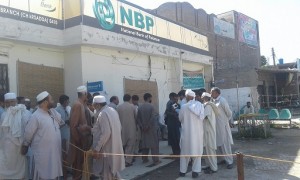The Pension Bomb
“The government is paying Rs470 billion on account of pensions [to former government employees or their spouses]. This amount is almost equal to the amount [Rs500billion] that we pay to the existing government employees as salaries. At many universities, the amount spent on paying pensions has increased more than spending on salaries. The problem must be streamlined even if we have to hire the world’s top consultant for it.” — PM Imran Khan
The pay and pension bill is going to haunt Pakistan’s economic managers in years to come, as it is becoming another monster just like circular debt. Federal pension payments have been growing at 18% a year, while provincial pension liabilities have been growing even faster. Such abnormal growth is taking a heavy toll on the development budget — the voters’ share. All other budget heads, whether salaries, defence, debt or markup payments, are quite inflexible. It’s the development budget that is likely to get squashed as pension payments balloon further. The annual pension payments by federal and provincial governments and state-owned enterprises are now touching a trillion rupees a year.
In 2015-16, the total budgeted pension allocation for military was 174.2 billion rupees and 56.7 billion rupees for civilians, in 2017-18,180 billion rupees was budgeted for military pensions (with revised estimates of 253 billion rupees) and 67.8 billion rupees for civilians revised upward to 80 billion rupees, and last year pensions as per revised estimates to the military rose to 354.9 billion rupees while for civilians it was 108.4 billion rupees. Thus in four years (2015-16 to 2019-20) military pensions rose by 103 percent while civilian pensions rose by 91 percent. During a cabinet meeting on 18 August, the Prime Minister reportedly stated that the issue of pensions is more serious than the issue of energy sector circular debt, adding that the government is paying 470 billion rupees on account of pensions – an amount equal to what the government pays as salaries to government employees.
The existing government pension system of Pakistan is fragmented, non-transparent, understudied and without any underpinning asset base. Federal government, provincial governments, armed forces of Pakistan, autonomous bodies and other government agencies are throwing forward the pension liability without any plan on how to meet the growing burden.
The government pension liability and the systemic underpinning need a comprehensive overhaul urgently. But, how can the government continue to pay pension without pain?
Pension is pegged with the base salary, without any employee contributions and after retirement, payouts are made from the budget. No one knows the amount of the government’s already accrued pension liabilities, owed to existing employees and pensioners through these pay-as-you-go pension schemes.
Many countries meticulously estimate their unfunded pension liabilities and some even account for them in their debt-to-GDP ratio. While it is difficult to calculate Pakistan’s total pension liabilities, without a detailed actuarial study across the federal and provincial governments, a guesstimate can be made. Punjab last had an actuarial valuation done in 2015, putting its unfunded accrued pension liability at Rs3.8 trillion — 34 times the province’s Rs112 billion pension expenditure. If that is taken as a benchmark, our overall pension liability can touch Rs33-34 trillion. This is as high as the total central government debt of Rs34 trillion.
There is a need to immediately cap these massive unfunded pension liabilities at their present level, by terminating this scheme for any future government employees. From here on, the government should follow different models for existing employees and pensioners versus the future employees. If somehow, all these pensions could be transitioned to a contributory scheme, it could very well save the government at least Rs500 billion a year, assuming 50% contribution by employees. This money can, then, be made available for development that can get politicians some votes.
Many public sector employees today will be pensioners of tomorrow, when the government will be forced to make unilateral cuts. Those cuts are going to be much more bitter than the modest contributions that have to be made today. And to sweeten the deal, the government could introduce a one-time increment to make the contributions more palatable.
For new employees, the government should introduce a fully-funded contributory scheme. Every month, the employees and the government should both make contributions, which should then be invested through a well-structured pension fund. The post-retirement payouts have to move away from defined benefit and should instead be linked with the contributions made.
India has successfully implemented such a model. Civil servants contribute 10% of their salary, which is matched by the central government. The proceeds of the fund are invested. When civil servants reach 60 years of age, 40% or more of the account balance is used to purchase an annuity policy, while the remainder is withdrawn as a lumpsum amount or as phased withdrawals till the age of 70, at which point the pensioners exit from the system. The pension fund is managed by the National Pension System Trust for the central government, but 26 state governments have also joined hands.
For existing employees and pensioners, any unilateral change in the pension structure would be politically very difficult. Therefore, the government should start from revising the elaborate three-generational eligibility structure, encourage a culture of contributions by starting with mandatory but modest deductions for the pension fund, offer incentives to employees to voluntarily opt for the new contributory pension scheme and start making budgetary allocations for future pension payments.
The government may consider additional measures to take the pension liabilities off budget. For instance, the government can earmark unproductive assets for sale or lease, transfer them to the pension fund, and match their duration with the pension liabilities. A similar model was tried by the French Pensions Reserve Fund, which received a significant portion of its seed equity from the privatisation of government assets. Other innovative measures could include buyout programmes, offering options to existing employees to accept immediate partial payments in lieu of full future benefits. This model was tried in Illinois, United States, where payments typically amounted to 60-70% of the market value of employee pension.
The pension bomb is ticking, and it is only a matter of time before it explodes. If it is not defused soon enough, the state may find itself in a quandary of who should it pay — its employees, pensioners or the citizens. There is just not going to be enough for all three to claim a share.
The pension liabilities are ballooning at a rapid pace, squeezing the development space fast. The long-overdue pension reforms are no more an option but a fiscal necessity and the sooner the government realises this, the better.
 Jahangir's World Times First Comprehensive Magazine for students/teachers of competitive exams and general readers as well.
Jahangir's World Times First Comprehensive Magazine for students/teachers of competitive exams and general readers as well.




